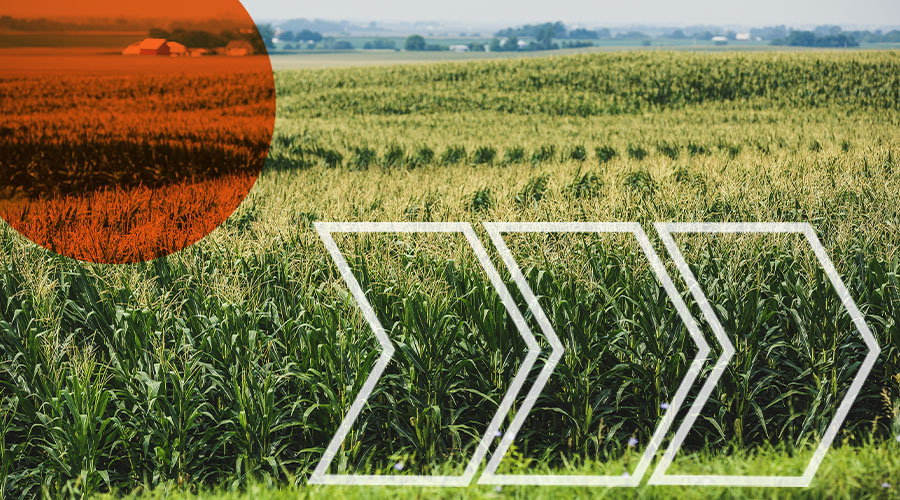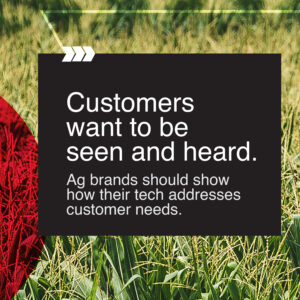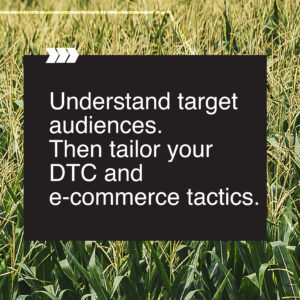2024 has been challenging for the agricultural industry. Whether you’re a grower, raising animals, producing chemicals and seed or innovating, the market has seen wild ups and downs, continued disruption through ag-tech, challenging global supply chain changes and unpredictable consumer habits.
As we roll into the fourth quarter and look to 2025, we’re zeroing in on four focus areas for marketers supporting hard-working ag brands that are vital to the global economy and the way we live.
Related Content: Forecasting and Futures Thinking to Impact the Present
#1: Digital Transformation and Precision Agriculture
The digital revolution has been underway for years across multiple segments of the ag industry. A growing emphasis on precision agriculture includes the use of advanced technologies like GPS, IoT and big data analytics to optimize farming practices. Marketers are also using these technologies to provide more personalized and targeted campaigns. Digital tools such as AI-driven analytics, customer relationship management (CRM) software and geolocation services are being used to find and target specific customer segments.
The challenge lies in crafting messages that resonate with farmers and agribusiness professionals who are increasingly data-savvy. Understanding their unique needs and proving how digital solutions can enhance productivity and profitability will be crucial for success.
Our Take on Digital Transformation and Precision Agriculture
Specific case studies emphasizing benefits and measurable outcomes gained by using digital tools can attract tech-savvy farmers looking for innovative solutions. For ag brands looking to position themselves as leaders in digital transformation, thought leadership content around the latest advancements in ag tech and their impacts will be key.
Additionally, it’s important that ag marketers keep current on tools in their own tech stack — including CRM systems and marketing automation platforms — that will help them deliver this relevant content to farmers and ag professionals precisely when they need it.
#2: Sustainability and Ethical Branding
While sustainability isn’t a new development for agricultural sectors, we’re seeing additional attention driven by consumer demand for ethically produced food. The emphasis on sustainable farming practices, organic products and reduced carbon footprints is influencing marketing strategies. Brands are increasingly aligning themselves with sustainability initiatives, not just as a matter of compliance, but as a core part of their brand identity.
Messaging that focuses on sustainability credentials (like FSC – Forest Stewardship Council), promotes organic and sustainable farming practices that align with consumer demands and amplifies leading voices in this space builds trust and attracts environmentally conscious consumers and investors. Storytelling around farm-to-table initiatives and partnerships with local communities are crucial to keeping brand appeal and health.
Our Take on Sustainability and Ethical Branding
Marketing executives should focus on building trust and authenticity through transparent communication about sustainability efforts. Highlighting a brand’s commitment to sustainable practices, from seed to shelf, can strengthen customer loyalty and enhance brand equity. Ethical branding isn’t just a trend; it’s a movement that is here to stay, driven by consumer expectations and regulatory pressures alike.
Be authentic. Highlight suppliers, partnerships and associations that help your audience and tell your story in a real way. Younger generations are research-oriented and critical when they believe they’re being greenwashed. We encourage ag verticals to find the story lines that are most true to your product.
#3: Building Trust and Authenticity Through Storytelling
Agriculture has always had a rich narrative. The story is becoming more important as consumers become more discerning, health conscious and aware of the impact ag has on the health of their families and communities. As consumer interest in food origin, food security and the impacts of climate change grows, brands should focus compelling narratives around their products and services. This includes showcasing the people who grow their food, the traditions behind their methods and the journey from farm to table.
One of our favorite Super Bowl spots from 2023, The Corporation, was produced by Illinois Farm Families and marked the launch of the coalition’s “We are the 96 percent” campaign. The campaign featured more than 25 farm families across the state with the goal of making Illinoisans aware that 96 percent of farms in the state are run by families. The spot aired during the first half of the 2023 Super Bowl, featured the Bell family from Mercer County, Illinois, and is a fantastic example of authentic storytelling focused on the producer.
Our Take on Building Trust and Authenticity
Leaning into the people and the processes that support ag related industries through deep storytelling and brand architecture are more important than ever, whether you’re putting seed in the ground, providing nutrition for livestock or processing the food that feeds families.
Effective storytelling in agricultural marketing goes beyond selling a product; it builds an emotional connection with the audience. Using a varied channel strategy — including social media, blogs and video content —ag brands — can create immersive experiences that resonate with consumers. Investing in high-quality content that tells your brand’s unique story will be key to standing out in a crowded marketplace.
Related Content: The Dynamic Duo: PR and Social Media as the New Heroes in Your Integrated Marketing Campaigns
#4: Direct-to-Consumer (DTC) Channels and E-Commerce Growth
The rise of direct-to-consumer (DTC) channels in agriculture is driven by the increased comfort in buying products online. E-commerce platforms are becoming vital for reaching consumers directly, bypassing traditional distribution channels.
For marketers, this trend offers an opportunity to engage directly with end consumers, understand their preferences and build stronger relationships. It even offers opportunities to integrate that data into the product roadmap and selling strategy.
While many large-scale ag verticals have focused on DTC for years, we’re seeing new opportunities for brands to grow their commerce chops.
- Virtual workshops or webinars to engage with customers and promote products are a strong DTC option, especially when paired with exclusive discounts to attendees who buy products during or after the event.
- By partnering with growers and social influencers, brands can offer custom, personalized boxes and experiences tailored to consumer tastes and trending preferences.
Businesses providing support services like soil testing, crop consulting or agricultural financing can develop digital offerings to reach farmers directly. By creating platforms where farmers can easily book services like soil testing, crop advisory or equipment maintenance, companies can level up for people seeking their products and services.
Our Take on DTC and E-Commerce
A robust online presence, combined with a seamless purchasing experience and targeted digital advertising, can significantly enhance brand visibility and sales. Additionally, subscription models and loyalty programs are popular ways to keep customer engagement and ensure repeat purchases.
Deeply understanding audience patterns is a critical component of a strong commerce or DTC program for ag verticals. We recommend a strong understanding of your target audiences before investing the effort to implement some of these solutions. Start with the intended outcome in mind and pilot before a mass rollout.
In Conclusion
The future of agricultural marketing is being shaped by technological advancements, shifting consumer expectations and the need for sustainable practices. As the industry continues to evolve, staying ahead of these trends will be vital for marketing executives and advertising professionals.
For those at the forefront, the opportunity lies in understanding shifting consumer and tech trends and translating them into actionable strategies that drive growth and foster long-term customer relationships.
What challenges are you currently facing? How are you prepared to meet them? Let’s Talk!








